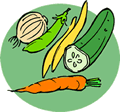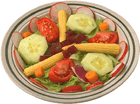|
Food is food, right? Well, unless you've been hiding in a well stocked fallout shelter for a couple of decades, you no doubt have seen countless news reports telling you what's good and what's bad when it comes to food. One aspect of food that is sometimes implied by such reports—but never specified or explored—is the difference between dead food and living food.
Before we explain the difference between the two, you may be wondering why you should care. The answer is simple: nutrient value and the health of your body. Living foods—especially fresh, raw foods—are more nutritious because they still have all of their vitamins, minerals, and enzymes (which the body needs to help you
 properly digest and metabolize food). These nutrients in food typically get clobbered during the processing, cooking, and packaging that dead food goes through. In the most egregious categories of dead foods—those that have refined flour and added sugar—they may actually suck stored vitamins out of your body as your system tries to metabolize them.
properly digest and metabolize food). These nutrients in food typically get clobbered during the processing, cooking, and packaging that dead food goes through. In the most egregious categories of dead foods—those that have refined flour and added sugar—they may actually suck stored vitamins out of your body as your system tries to metabolize them.
Now, back to dividing up our comestibles into the living food and dead food categories. Generally, if a food spoils quickly, it's a living food. Fresh fruits and vegetable fall into this category, as do milk and cheese, freshly made baked potatoes and potato dishes, and freshly baked breads. If a product is more resistant to spoilage than a Teflon-coated nacho chip, it's dead food. But in some cases, just using the spoil-o-meter test to determine whether an item is a living food or dead food is too simplistic. For instance, grains, if properly stored, can be milled or sprouted many years later to make high-quality living food. Similarly, nature has designed raw nuts and seeds—for example, hazelnuts, almonds, and sunflower seeds—to be fairly resistant to spoilage, and they too are excellent living food.
Several categories of food deserve special mention:
- Meat and Fish – Some would argue that the flesh of dead animals by definition cannot be living food. Those who can stick to a vegetarian diet do accrue certain health benefits from it and are to be commended for choosing a "food lifestyle" that is healthy, animal friendly, and environmentally friendly. But those interested in the living food concept should not feel they have to go vegetarian to begin adopting a living food diet.
- Processed Food – The rule here is easy: The more milled, cooked, and dried-out a product is, the deader it is. Items that fall into the crispy/crunchy category are particularly dead.
 Raw Food – Raw vegetables, fresh fruit, unroasted nuts and seeds, and sprouted grains, beans, and legumes are at the top of the living food pyramid. They are packed with vitamins and enzymes, all perfectly intact because the food is fresh and unaltered by heat, processing, or containerized storage.
Raw Food – Raw vegetables, fresh fruit, unroasted nuts and seeds, and sprouted grains, beans, and legumes are at the top of the living food pyramid. They are packed with vitamins and enzymes, all perfectly intact because the food is fresh and unaltered by heat, processing, or containerized storage.- Cooked Food – Living-food purists will argue that cooking greatly reduces the nutrient value of all food and creates new compounds within the food that are inimical to health. In an interview on living-food.com, author David Wolfe asserts, "You cannot revitalize [your body's] living cells with dead food." We do agree that raw food is superior in terms of active vitamin, mineral, and enzyme content. But, as with meat, we're going to suggest that you not let the perfect be the enemy of the good; that you can get plenty of benefit by increasing the amount of fresh, uncooked food in your diet without feeling that you have to go 100% raw.
So, those are the general rules for determining what is living food vs. dead food. Here are some specific examples:
| |
|
| |
Potato |
Potato chips |
|
| |
Wheat bread |
Wheat crackers |
|
| |
Beef |
Beef jerky |
|
| |
Fresh fruit |
Fruit rollups |
|
| |
Fresh vegetables |
Vegetable chips |
|
| |
Toast* |
Melba toast |
|
| |
Oatmeal** |
Boxed cereal |
|
| |
Peanuts |
Peanut brittle |
|
| |
* Living, but less so than the original bread
** Oatmeal is not a perfect living food—you'd have to make your cereal from oat groats to achieve that—but it's far better than the crispy, crunchy, sugary, highly heated, desert-dry oat cereal you get out of a box. |
|
In some cases, how a food item was made determines whether it's living or dead. For instance, juices are tricky because there are so many ways to make juice and related beverages.
Freshly squeezed juice – Fresh juices from vegetables and fruits are very much living food. They usually qualify as "super foods"—the tippy top of the nutrient-dense living food pyramid.
Juice from a carton, bottle or can – This is a big step down from freshly pressed juice (or from just eating the raw fruits and vegetables themselves). Processing, heat, storage, and exposure to sunlight all take their toll on vitamin and enzyme
 content. Bottled and canned juices that are 100% juice aren't particularly bad to consume; they just aren't anywhere near as good as fresh-pressed juices.
content. Bottled and canned juices that are 100% juice aren't particularly bad to consume; they just aren't anywhere near as good as fresh-pressed juices.
Juice drinks – Any beverage that contains only 10% juice, with the rest being water and sweetener, has 9 of its 10 toes in the dead-food category.
Flavored soft drinks – These are dead, dead, dead. A smattering of "natural flavors" does not save these products from being considered dead food.
To get the maximum punch of the vitamins, minerals and enzymes your body needs to run well, stick with raw, living food as much as possible. Living food is not only better for you than dead food, it's better for the environment too. When you buy
 living food, you eliminate the energy, raw materials, and waste products associated with processing the food and storing it in cans, bottles, boxes, and shrink wrap. And the more raw food you eat, the less energy you use for cooking.
living food, you eliminate the energy, raw materials, and waste products associated with processing the food and storing it in cans, bottles, boxes, and shrink wrap. And the more raw food you eat, the less energy you use for cooking.
We do have to admit that unless you're in monk training, it's going to be pretty hard to get completely away from dead food. But there are plenty of times when choosing living food is plenty convenient—even if it's not quite as fun. Sometimes it's just a matter of better planning; for instance, consider keeping a bag of natural trail mix in your desk drawer rather than a bag of chips.
|


